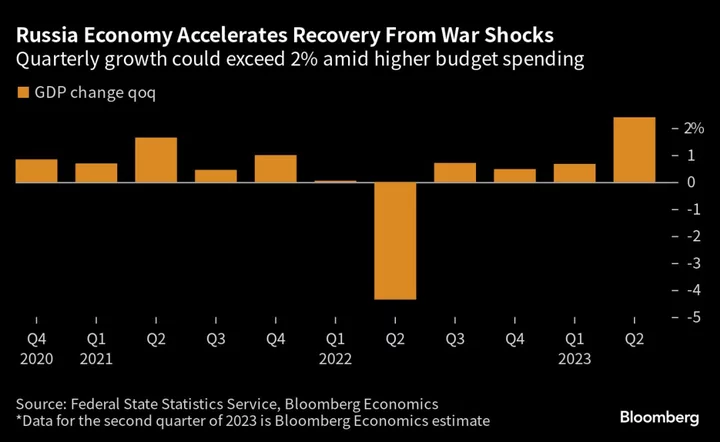Russia’s economy may return to its pre-war level as soon as next year as it adapts to the impact of international sanctions, though the Kremlin’s drive to expand military recruitment may yet undo this goal.
The economy expanded by an estimated 4.6% in the second quarter and by 1.5% in the first half of the year, Prime Minister Mikhail Mishustin said Friday at a meeting with officials. The Federal Statistics Service is due to report second-quarter gross domestic product later Friday.
Deepening labor shortages are adding to Russia’s difficulties as the Kremlin seeks to draw more volunteers into joining President Vladimir Putin’s faltering invasion of Ukraine that’s now in its 18th month. That may prompt a shift toward more selective measures for drafting people whose absence won’t be felt as strongly in the workplace.
Putin last week signed legislation that raises the draft age to 30 from 27 in January and bans men from leaving the country once they have received a digital conscription notice. The measures may permit “targeted mobilization” that would boost short-term growth by reducing the impact of labor shortages and allow the economy to reach its pre-war size by mid-to-late 2024, soon after scheduled presidential elections, according to Bloomberg Economics Russia economist Alexander Isakov.
Still, “opting for conscript mobilization is unlikely to reverse the decline in long-term growth,” he said.
The GDP data means Russia’s economy has expanded for four successive quarters, following a decline of more than 4% a year ago, defying predictions of a prolonged slump in response to the sanctions imposed over the February 2022 invasion of Ukraine. Increased defense spending has boosted industrial production while consumer demand is gaining momentum amid greater outlays on social support and higher wages.
Even so, the ruble is approaching 100 per dollar after weakening almost 25% since the start of the year, a slump central bank Governor Elvira Nabiullina has blamed largely on the deterioration in foreign trade conditions.
While flows of imports remain stable, restrictions on Russia’s energy sales, including an oil price ceiling imposed by Group of Seven nations, have led to a steady decline in export revenue that has brought the current account surplus to its lowest in two years.
Bank of Russia Halts FX Buys as Ruble Slumps Near 100 to Dollar
The economy may reach its pre-war size by the middle of next year, said Natalia Lavrova, chief economist at BCS Financial Group, who forecasts 2% growth in 2023. “You have to expect something very different from the consensus to get another estimate of the timing,” she said.
The Bank of Russia recently upgraded its full-year growth forecast to 1.5-2.5% for 2023, noting that output in most sectors focused on domestic demand had reached or even exceeded pre-war levels. It sees growth next year at 0.5%-2.5% and 1%-2% in 2025.
SURVEY: Russia Economy to Expand 0.6% in 2023; Prior +0.4%
Policymakers have warned that the “capacity to expand production in the Russian economy is increasingly limited by labor market conditions,” which are helping to stoke inflation risks alongside sanctions and surging government spending linked to the war.
“If we are talking about the full year’s number, in 2024 Russia will already go beyond the level of 2021,” said Rosbank economist Evgeny Koshelev in Moscow.

